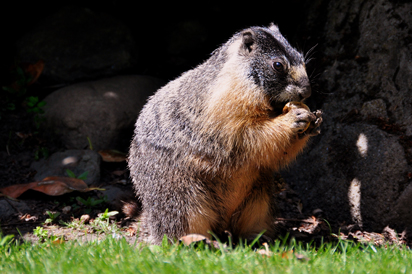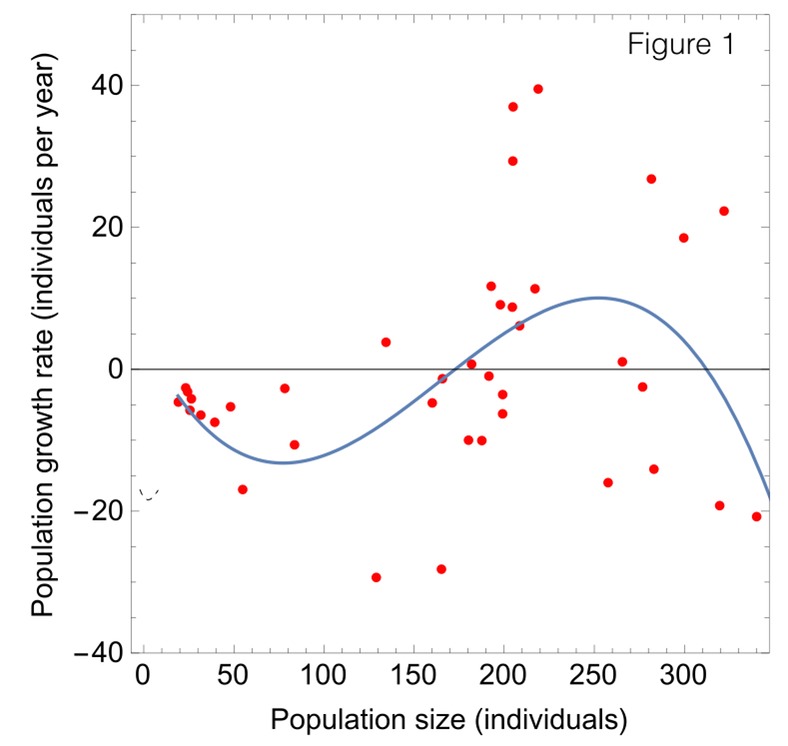
The Vancouver Island Marmot is a large species of rodent that lives exclusively on Vancouver Island in British Columbia, Canada. Although the number of individuals of this species was once in the hundreds, its population size declined to below 50 individuals around 2001 as a result of habitat destruction.
The species is now in serious danger of extinction and studies have been undertaken to assess the likelihood that the population will grow back to its previous size. To this end, in each of several years, researchers measured the population size as well as the population growth rate (the change in population size from one year to the next). They then plotted the growth rate against population size and fitted a curve to the data. Figure 1 presents their data.

Each red dot corresponds to a particular year, and the solid curve is a cubic polynomial fitted to the data (the data can be downloaded from the link on the left). This curve is an example of the function in Example 7.2.6 of the textbook.
Although there is a lot of scatter around the fitted curve in Figure 1, it shows that the expected population growth rate is negative for population sizes between 0 and approximately 170. This reveals a clear Allee effect. The Allee effect is extremely worrisome from a conservation perspective because it suggests that, without intervention, the population will decline to extinction once it drops below about 170 individuals. The researchers of this study were also able to show that the reason for the Allee effect is the difficulty that individuals have in finding mates once the population size gets small.
We can use an analysis like that in Example 7.2.6 to determine if there are any predicted equilibria for the Vancouver Island Marmot population as well as their stability properties. The curve in Figure 1 is given by the function
We can find the values of N at which this crosses the horizontal axis by looking for the roots of this cubic polynomial. Using a CAS these are found to be approximately 10, 172, and 309. These last two of these values correspond to the constants a and K in Example 7.2.6.
A marmot population size of 172 individuals is predicted to be an equilibrium, but an unstable one. Below this population size individuals have such difficulty finding mates that the population declines. Above this population size individuals can find mates easily enough that the population grows.
A marmot population size of 309 individuals is predated to be a stable equilibrium. Below this population size there are abundant enough resources that the population grows. Above this population size resources are so scarce that the population declines.
The model also predicts that a marmot population size of 10 individuals is a stable equilibrium. However, closer examination shows that this is an artefact of how the cubic polynomial in Figure 1 was fit to the data. You will note from Figure 1 that there are no data points below a population size of 19 individuals. As a result, extrapolating predictions to population sizes below 19 can be dangerous. That said, from a biological standpoint we know that the growth rate of the population must be zero when the population size is zero (that is, the growth rate of the population must be zero when the population is extinct). Thus, when fitting the curve to the data we might impose the additional constraint that the curve must pass through the origin. The cubic polynomial fit to the data in Figure 1 is not forced to satisfy this constraint and therefore it passes through the horizontal axis at approximately N=10 rather than N=0.
The above considerations illustrate that we must always bear in mind any potential limitations of a model when interpreting its predictions. Remember, models are meant to be simplifications of reality. They should teach us something useful about biology (in this case that, if the marmot population drops below around 172 individual, then it is in danger of extinction) but we do not expect any model to provide a completely accurate representations of reality.
References
Data are from Brashares, J.S., J.R. Werner, and A.R.E. Sinclair. 2010. Social ‘meltdown’ in the demise of an island endemic: Allee effects and the Vancouver Island marmot. Journal of Animal Ecology 79:965-973